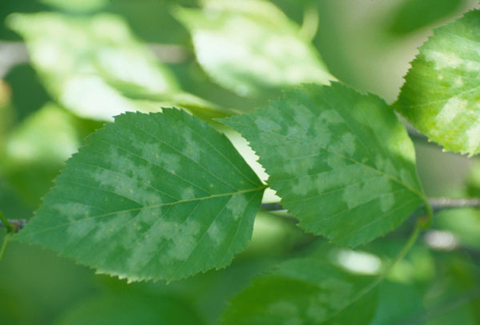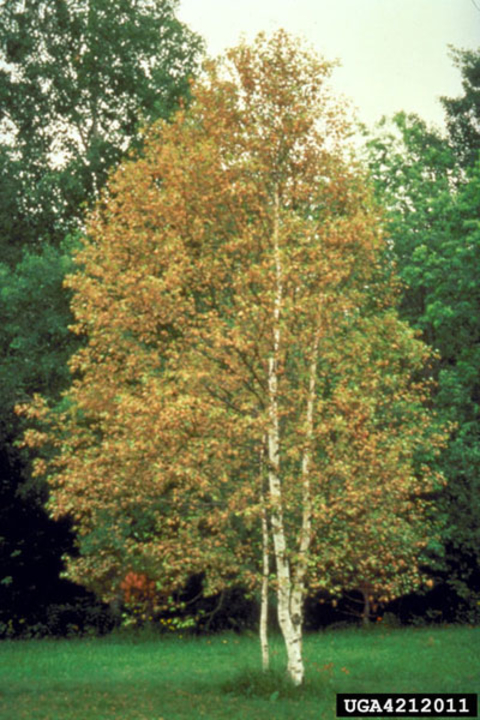Quick facts about birch leafminers
- Birch leafminers (Fenusa pusilla) are among the most common insects affecting landscape trees and shrubs in Minnesota.
- They feed inside the leaves of gray, paper, river and European white birches.
- They form blotch mines, where partial or whole areas inside the leaves are consumed.
- Birch are treated most often to protect the tree’s appearance and not for the tree’s health.
How to identify birch leafminers
- Adult birch leafminers are about 1/8 inch long, black and fly-like.
- Larvae are yellowish white, legless and up to ¼ inch long.
Larvae can sometimes be seen when leaves are held up to sunlight, especially as the mines and larvae grow larger.
If you see partial or whole areas of leaves that are consumed, it is a sign of the presence of birch leafminers.
Early mines appear as light green or whitish discolorations on the leaves.
Life cycle
In Minnesota, birch leafminers normally produce two generations a year. They live through the winter in the soil as pupae.
Adults emerge about mid-May in central Minnesota, approximately when the leaves first start expanding.
Females deposit one egg at a time in slits made on leaves. More than one female may lay eggs in a leaf.
The eggs hatch into legless, worm-like insects. These immature larvae feed between the leaf surfaces and create kidney-shaped mines. They feed for about two weeks, then drop to the ground and develop into pupae.
In about 2-3 weeks, the pupae give rise to second generation adults. Around mid-June , these adults lay eggs in newly developing leaves. The larvae again feed for two weeks, drop into the soil and transform into pupae. These pupae stay in the soil until next spring.
Damage caused by birch leafminers
Areas of leaves consumed by leafminers turn brown. If you miss the early signs of leafminer feeding, it may seem that the birch has suddenly dried up.
First generation leafminers do not cause serious injury to healthy, mature birch.
Generally, leafminer damage does not affect more than 40% of the leaves. Even if it affects more than 60% of the leaves, well-watered birch trees can tolerate the damage.
Damage caused by second generation leafminers is less serious, because they do not attack fully expanded leaves.
In very rare situations, when the birch are severely stressed and unhealthy, e.g. during the drought conditions of 1987-1989, birch leafminer damage can lead to tree death.
Birch leafminers and Bronze birch borers
There is no relation between feeding by birch leafminers and attack by bronze birch borers. Bronze birch borers generally attack unhealthy birch.
Birch leafminer and bronze birch borer damage differs from each other:
- Damage due to bronze birch borer starts at the top of the tree and ends of branches, before moving inward.
- Leaves damaged by birch leafminers are scattered throughout the tree.
How to protect your garden from birch leafminers
It is unnecessary to treat birch leafminers for the health of the tree.
When you see numerous large blotches, the leafminer has completed its development. At this stage, control is not suggested since the damage is done and the larvae have left the leaves.
Watch for the presence of leafminers in your trees
Monitor birch carefully in the spring.
- The best time to treat birch leafminers is when larvae first hatch inside the leaves and begin to feed.
- Treatment at this time minimizes damage to birch.
It is difficult to identify this stage.
- Tracking particular plant events, like bud break, might help in predicting when the leafminers will begin feeding.
- First mines generally appear 10 days after birch bud break
Birch leafminers in central Minnesota begin mining leaves around May 15. In southern Minnesota, expect first mines approximately 7 days earlier and in northern Minnesota approximately 7-10 days later. Adjust your timing when an early or late season is encountered.
Using pesticides
Once you find early mines on the leaves, pick one of the treatment options:
- Apply a systemic pesticide, such as acephate or dimethoate to the leaves. Systemic pesticides are effective because they are absorbed into the leaf tissue, killing the insects.
- Paint undiluted Cygon 2E on the bark at bud break. It is a systemic pesticide, that moves through the trunk and branches to the leaves. This method is less effective on large trees.
- Contact a plant health specialist. They use the Kiornitz injection system:
- to apply Metasystox-R into soil when leafminers are first active in the leaves
- to apply imidacloprid into soil the previous fall for controlling birch leafminers in the spring
These pesticides and the Kiornitz injection system are not available to the general public.
Control is rarely needed to protect the health of birch from second generation leafminer feeding.
CAUTION: Mention of a pesticide or use of a pesticide label is for educational purposes only. Always follow the pesticide label directions attached to the pesticide container you are using. Remember, the label is the law.
Reviewed in 2018




